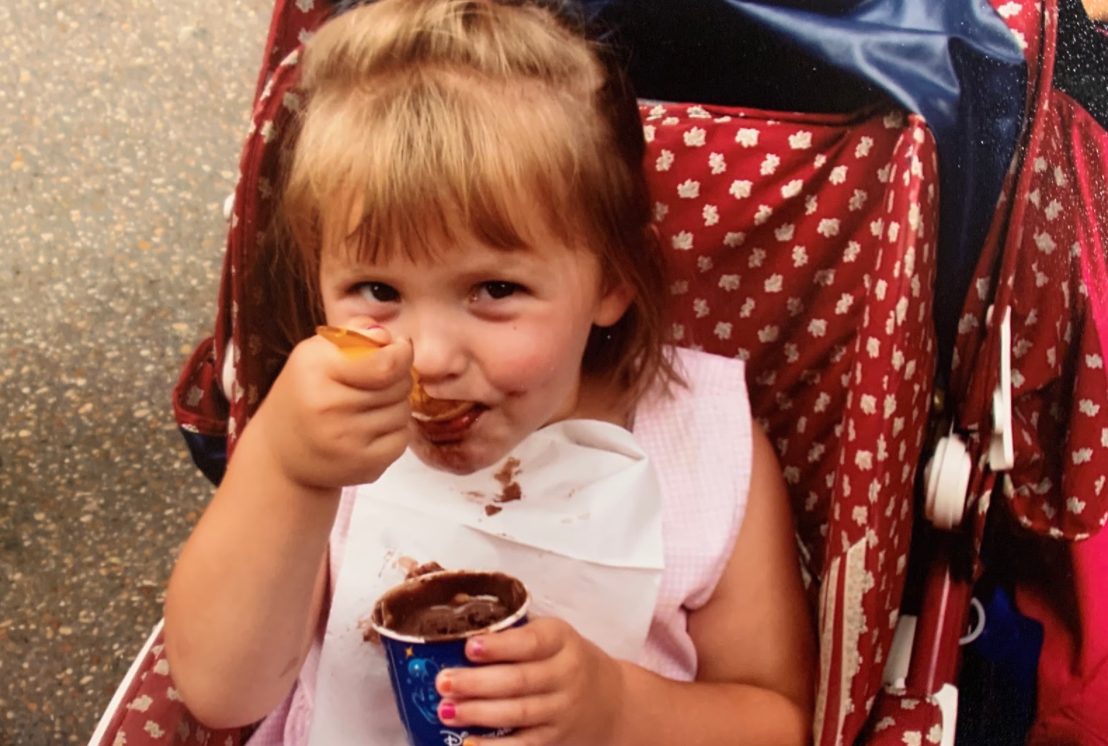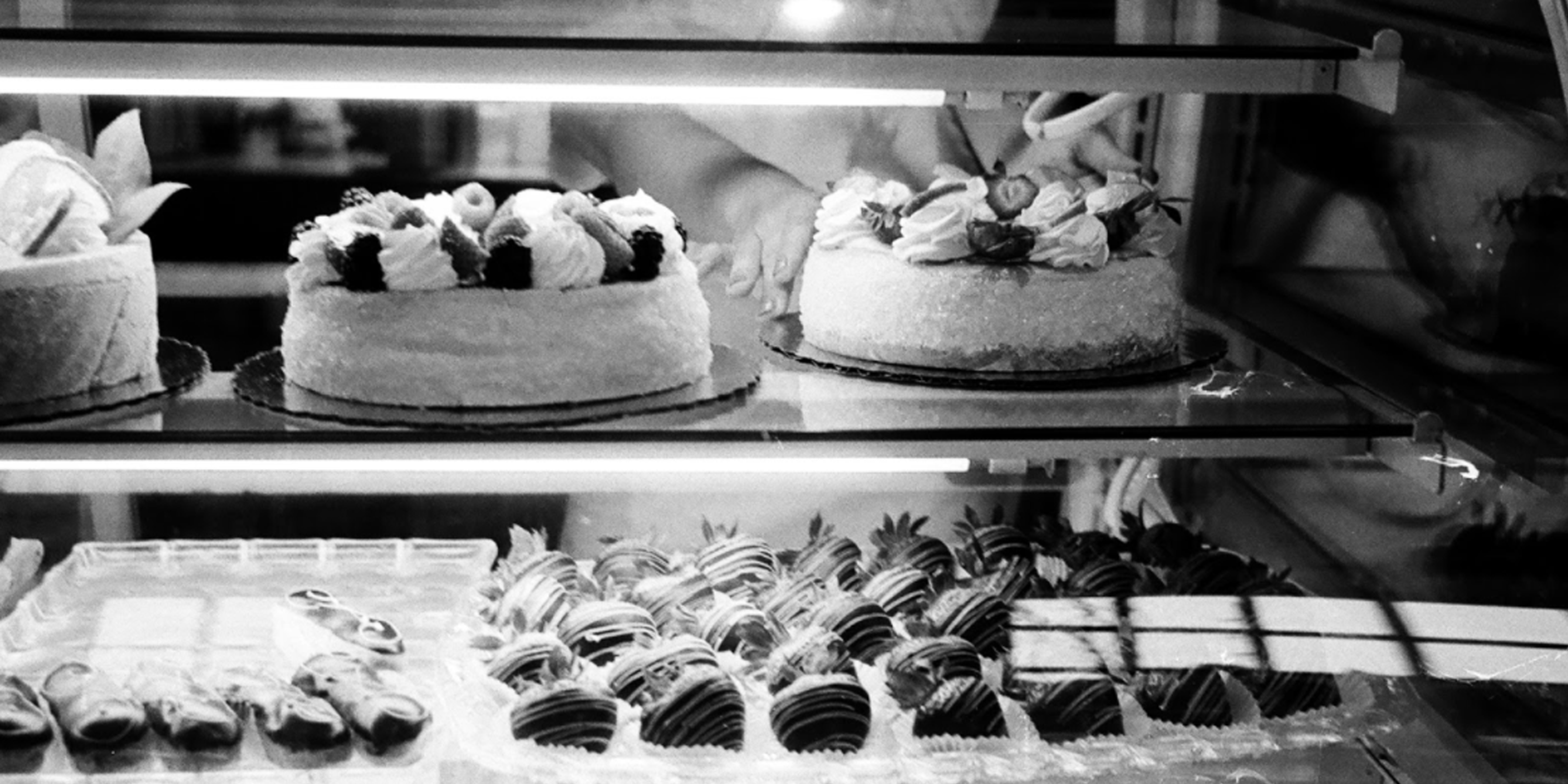A personal piece about allergies and intolerances
When I was a little girl, I had black and blue circles under my eyes 24/7. My mom would make jokes about raccoons, and my sister would say it looked like I’d been punched in the face. I had stomachache’s every day and headaches that would leave me in bed for hours. It took 13 years for my family to realize that my low energy and chronic illnesses were due to the food I was eating.
And oh my gosh, did I love my food. I used to sigh in delight at coming home to the smell of pizza in the air and eating cheesy lasagna or buttered noodles with second helpings every time. I would point to the eclairs and pain au chocolats with wide eyes and a deep smile on my face every time we passed a bakery. In our family photo album of a trip to Disneyland Paris, all of the photos show me with chocolate ice cream on my nose or fully concentrated mid-bite eating a crepe.

Young Sophia Gibbons eating ice cream. Image courtesy of Sophia Gibbons (14 East)
So, when I say that “everything I love tries to kill me,” I’m not kidding. Flash forward to today — what is it exactly that I can’t eat? Gluten, dairy, soy, corn, yeast, walnuts, hazelnuts, pecans, sesame seeds, banana, kiwi and the list goes on. With my combination of severe allergies, intolerances and sensitivities, it’s doubtful I’ll be able to eat over 95% of the products in the rows and rows of grocery stores.
It began with an allergic reaction that changed everything — a cookie when I was 8 years old. My best friend’s brother had come home from a vacation in Thailand with a box of cookies, which we both ate in secret after strict orders of “no candy.”
The effects began slowly, but then hit like an avalanche as they continued to tumble out of control — stomachache, nausea and then my throat and nose closing. Thankfully, my friend’s mother was a nurse who recognized the sign of an anaphylactic allergic reaction and called my parents. Until the moment I was rushed to the hospital, my family had no idea I was allergic to hazelnuts.
I believe that everyone who has ever had an anaphylactic allergic reaction can tell you that it can be quite traumatizing. Your mouth swells and itches, and your stomach feels 10 times heavier. Your vocal cords feel like sandpaper until they close and you can no longer breathe. I can still remember exactly how that felt. I was reminded last summer, while on my study abroad in Italy, and these symptoms creeped in after eating yet another foreign cookie. That was the only time I’ve ever had to use my EpiPen.
When I was 12 years old, my dad was diagnosed with celiac disease. I guess the apple doesn’t fall far from the tree, because the following year I met with the same doctor and nutritionist who gave me the same diagnoses, as well as deeming me severely lactose intolerant.
For those that don’t know, celiac disease is a serious autoimmune disorder that triggers a reaction when eating gluten that damages the small intestine. Basically, my favorite foods like the magical eclairs and amazing crepes were hurting me with each bite. But after months without these foods, the circles under my eyes disappeared, and I no longer had daily stomachaches.
I really didn’t know how people had so much energy all the time. Each day had felt like lifting dead weights.
However, life is never that simple. Four years later when I was in high school, these symptoms reappeared. I would lie in bed for hours. I had no energy left after a day at school. My body felt weak, and my brain would often get confused. I felt like I was in a lull, not actually living but just watching from a distance. To this day, I barely hold any memories of my sophomore and junior years of high school as they were so clouded by brain fog and anxiety.
The mystery was solved the autumn after my 19th birthday. A blood test revealed a sensitivity to corn, soy and yeast. After just three weeks of not eating these foods, I turned to my dad and said, “Are people supposed to have this much energy every day?”
My entire conscious life since early childhood was a suppressed immune system, days of headaches and tears. I really didn’t know how people had so much energy all the time. Each day had felt like lifting dead weights.
But on that day in autumn, I finally felt everything click. I no longer had anxiety holding me so tightly around the wrists, no longer had a bloated stomach or felt so weak that I could blow away in the wind. When I returned to college for my sophomore year, my best friend and her mother looked at me and said, “Sophia! You actually have color in your cheeks!”
My relationship with food is a constant journey. There are days I feel great, and days that I don’t. But it’s just something to be mindful of. To me, it’s not a diet — it’s a lifestyle.
Making these changes gave me my life back. I wake up with energy, with trust in my body and a sharper mind. And if that means not being able to have that delicious slice of chocolate cake at the bakery my sister works at … so be it.
Sometimes, people ask me why I don’t just have a slice of pizza, or eat a bite of cake or just let go for an afternoon. And the answer is simple — I remember so vividly what it was like living without trust in my body or my mind. I remember the days of crying at the front door begging not to go to school because everything just hurt too much. I remember getting off the train in downtown Chicago, suddenly unaware of where I was going or what I was doing — brain fog at its finest.
I remember, and try my hardest to never forget. I do this so that I know to do whatever is in my control to never feel that way again.
One thing I want to make clear, is that just because this works for me doesn’t mean it will work for everyone. I have a restricted diet for my own health and well-being, which is different from restricting for societal pressure. Everyone has a different relationship with their body, and our bodies all need to be taken care of in numerous ways. I always tell friends to talk to a nutritionist or doctor before making a change in their diet, to gather the correct information so that you can make the best choice for you. It’s also important to note that health and wellness is a combination of a circle of factors — environmental, physical, mental and emotional — and it’s more than okay to prioritize your mental and emotional health.
The racoon eyes only appear once in a blue moon now. I feel the healthiest I’ve ever felt in my life, and I want to continue to optimize that for me. Yes, food around me keeps trying to kill me. But, in making these changes I actually feel more connected and appreciative of the foods I’m eating. I know exactly where they’ve come from and what’s in them. I know that they’re making me feel good, and that in the long run going to help me live a happy life. And, that’s something I’ll always be grateful for.
Header image by Sophia Gibbons




NO COMMENT